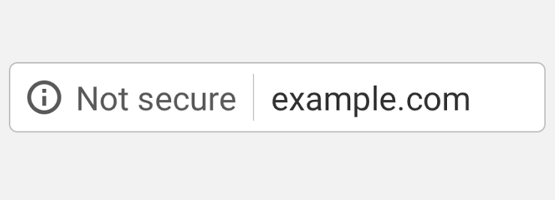 Earlier this year we published a blog on why websites are being labelled as “not secure” in the Chrome web browser.
Earlier this year we published a blog on why websites are being labelled as “not secure” in the Chrome web browser.
We won’t repeat that same blog here, so if you haven’t already, we suggest reading that article first. That will give you a good background of what’s happening.
From next week, most likely next Tuesday (17th October), Google will issue its latest release of the Chrome web browser, version 62. For users of the Chrome browser, these updates get installed automatically on your computer.
If you have a HTTP website (not a HTTPS website), this new version of Chrome will bring changes to how your website is labelled.
A brief summary of HTTPS:
There’s basically two types of pages on the internet:
- HTTP – how most webpages typically worked.
- And HTTPS – secure, encrypted webpages, which are signified by the padlock symbol in your web browser’s address bar. It’s much harder for hackers to pry on what you’re reading or intercept your passwords when you load a HTTPS webpage, compared to a HTTP (non-encrypted) page.
Since January 2017, Google is persuading all website owners to move to HTTPS, because they believe it’s for the good of everyone.
What’s changing in Chrome v62?
Since January 2017, Chrome will label any HTTP webpages that contain a password box with a “Not secure” label, which looks like this:

If your website is still using HTTP, not HTTPS, you may have noticed this warning label when going to your website’s login page.
From next week, in the new version of Chrome, this warning label will extend to all web forms on HTTP websites. This will include:
- Contact forms
- Search boxes
- E-commerce forms
- And any other input boxes
So, for example, if you have a contact form on your website, as soon as somebody clicks into the form and starts entering their details, this warning label will appear. This means the “Not secure” warning suddenly becomes a lot more visible to your visitors.
Also, anyone visiting your website using Chrome’s incognito mode will see this “Not secure” label on all your webpages too, regardless of whether you have any forms.
This only applies if you have an older HTTP website. If you have a HTTPS website already, then no warning will of course appear and you’re all set!
You can read more about these changes on Google’s blog.
What’s going to happen in the future?
Google have announced that future versions of Chrome will come with even more prominent warnings for HTTP websites. At a later date, every single HTTP webpage will be labelled as “Not secure”, with a clear red warning symbol:
What should I do?
We recommend all websites move to HTTPS. There’s plenty of benefits why you should use HTTPS.
We offer a HTTPS conversion service for both our customers and externally-hosted websites. See what’s involved and our prices.
Mike founded Primary Image in 2010. He specialises in the WordPress website platform and speaks regularly at national web design conferences. Mike became a member (MCIPR) of the Chartered Institute of Public Relations in 2015.


